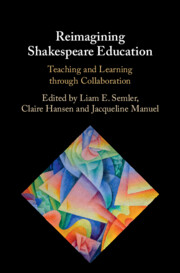Book contents
- Reimagining Shakespeare Education
- Reimagining Shakespeare Education
- Copyright page
- Dedication
- Contents
- Figures
- Tables
- Notes on Contributors
- Acknowledgements
- Introduction
- Part I Reimagining Shakespeare with/in Schools
- Part II Reimagining Shakespeare with/in Universities
- Part III Public Reimaginings
- Part IV Digital Reimaginings
- Introduction
- Chapter 13 Reimagining Shakespeare, Linking Archives and the ‘Living Variorum’
- Chapter 14 Collaborative Rhizomatic Learning and Global Shakespeares
- Chapter 15 Linked Early Modern Drama Online
- Chapter 16 Play the Knave Theatre Videogame in Schools
- Part V Reimagining Performance
- Afterword
- Index
- References
Chapter 14 - Collaborative Rhizomatic Learning and Global Shakespeares
from Part IV - Digital Reimaginings
Published online by Cambridge University Press: 02 February 2023
- Reimagining Shakespeare Education
- Reimagining Shakespeare Education
- Copyright page
- Dedication
- Contents
- Figures
- Tables
- Notes on Contributors
- Acknowledgements
- Introduction
- Part I Reimagining Shakespeare with/in Schools
- Part II Reimagining Shakespeare with/in Universities
- Part III Public Reimaginings
- Part IV Digital Reimaginings
- Introduction
- Chapter 13 Reimagining Shakespeare, Linking Archives and the ‘Living Variorum’
- Chapter 14 Collaborative Rhizomatic Learning and Global Shakespeares
- Chapter 15 Linked Early Modern Drama Online
- Chapter 16 Play the Knave Theatre Videogame in Schools
- Part V Reimagining Performance
- Afterword
- Index
- References
Summary
Cooperative learning as a pedagogical method effectively reflects the communal character of the performing arts. By creating knowledge about Shakespearean performance collaboratively, students and educators lay claim to the ethics and ownership of that knowledge, an act that is particularly urgent and meaningful in the age of COVID-19 when we need to rebuild sociality.
This chapter demonstrates how communal writing assignments and digital, video-based pedagogy turn textual and performative variants in Shakespeare’s plays into a cluster of inclusive narratives for critical analysis. Shakespeare is no longer a white canon with culturally predetermined meanings.
One effective tool for communal writing assignments is Perusall.com, an open-access platform that incentivize and support collaborative annotation of texts, images and videos. Grounded in the notion of textual variants, the pedagogy encourages students to claim Shakespeare’s language rather than aiming for interpretations that are gratuitous or merely politically correct.
Working in tandem with collaborative textual analysis is video-centric collaboration. By turning a large number of performance versions into common objects of study, my digital video project makes links between adaptations that were previously regarded as distinct. In pedagogical contexts, the malleability of digital video puts play texts and performances to work in an interactive environment. Online performance video archives can encourage user curation and interaction with other forms of cultural records. In practice, this redistributes the power of collecting, re-arranging and archiving cultural records away from a centralised authority to the hands of student users.
Keywords
- Type
- Chapter
- Information
- Reimagining Shakespeare EducationTeaching and Learning through Collaboration, pp. 225 - 238Publisher: Cambridge University PressPrint publication year: 2023



